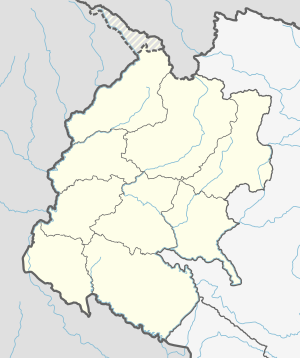Kailari is a rural Municipality in Kailali District in Sudurpashchim Province of Nepal.[1] It is surrounded by Bajani Municipality In the East, Dhangadhi Sub Metropolitan City in the West, Gauriganga Municipality and Ghodaghodi Municipality in the North and Uttar Pradesh, India in the South.
Kailari Rural Municipality
कैलारी गाउँपालिका | |
|---|---|
| Coordinates: 28°34′N 80°49′E / 28.57°N 80.82°E | |
| Country | |
| Province | Sudurpashchim Province |
| District | Kailali District |
| Government | |
| • Chairperson | Laju Ram Chaudhary (NCP) |
| • Vice-chairperson | Laxmi Satgauwa (NCP) |
| Area | |
| • Total | 233 km2 (90 sq mi) |
| Population (2011) | |
| • Total | 47,987 |
| • Rank | 6th (Nepal) |
| • Density | 210/km2 (530/sq mi) |
| Time zone | UTC+5:45 (Nepal Time) |
Demographics
editAt the time of the 2011 Nepal census, Kailari Rural Municipality had a population of 47,987. Of these, 88.5% spoke Tharu, 5.5% Nepali, 2.8% Doteli, 1.4% Achhami, 1.0% Maithili, 0.2% Bajhangi, 0.2% Bhojpuri, 0.1% Baitadeli, 0.1% Darchuleli, 0.1% Newar, 0.1% Sign language, 0.1% Urdu and 0.1% other languages as their first language.[2]
In terms of ethnicity/caste, 89.3% were Tharu, 3.5% Chhetri, 2.5% Kami, 1.9% Hill Brahmin, 0.5% other Dalit, 0.5% Damai/Dholi, 0.5% Magar, 0.4% Thakuri, 0.2% Sarki, 0.1% Badi, 0.1% Lohar, 0.1% Musalman, 0.1% Newar, 0.1% Rajbanshi and 0.1% others.[3]
In terms of religion, 97.6% were Hindu, 2.2% Christian, 0.1% Buddhist, 0.1% Muslim and 0.1% others.[4]
In terms of literacy, 62.9% could read and write, 2.0% could only read and 35.2% could neither read nor write.[5]

